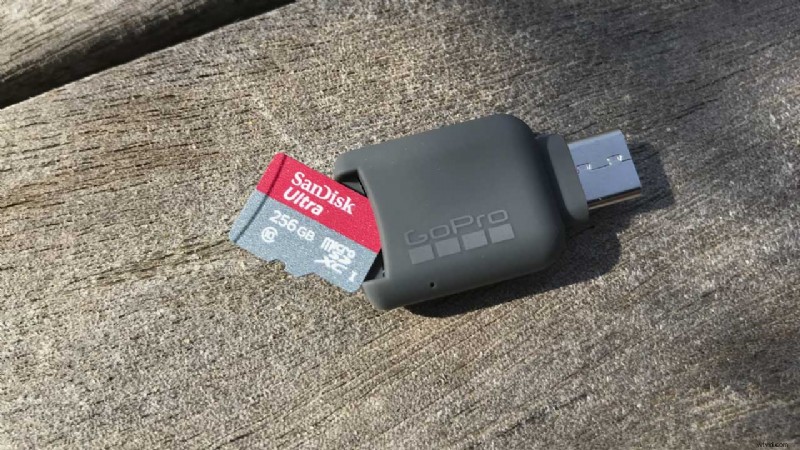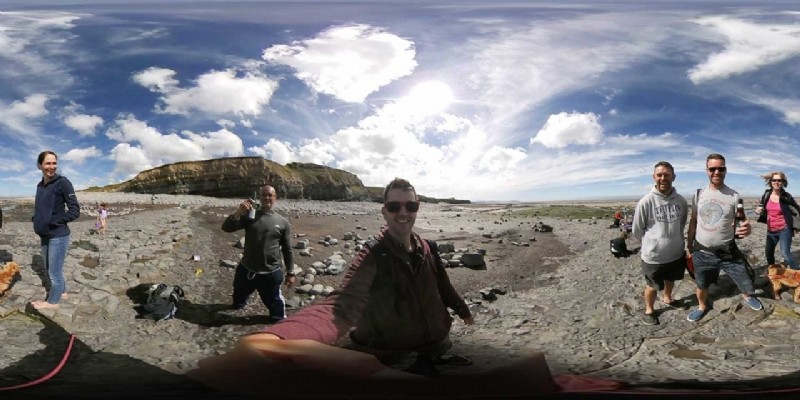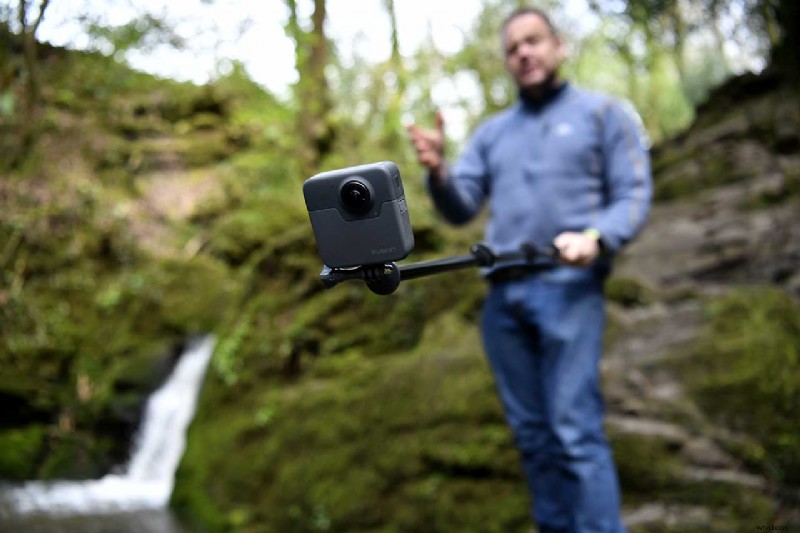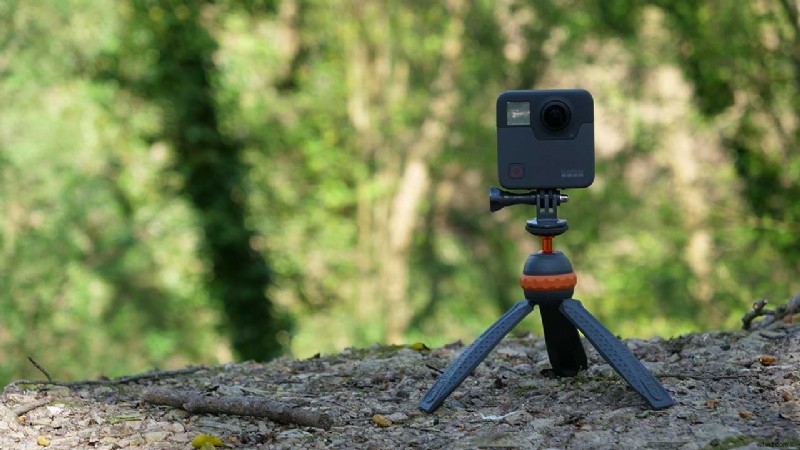La tecnologia emergente nelle fotocamere 360 ha consentito ai fotografi di catturare scene come non avevano mai fatto prima. Ma per utilizzare questa tecnologia 360 al suo pieno potenziale è necessario pensare alla composizione, all'esposizione e ad alcuni degli altri fondamenti della fotografia e della videografia, in modi completamente diversi. C'è una discreta quantità di tentativi ed errori coinvolti nella realizzazione di video e foto 360, ma si spera che questi suggerimenti e trucchi per la fotocamera 360 che abbiamo raccolto dalla nostra esperienza testando la tecnologia più recente ti aiuteranno a iniziare a creare contenuti sferici di cui essere orgoglioso.
Hai dei fantastici suggerimenti per la tua fotocamera 360? Scrivici e lo aggiungeremo all'elenco con un accredito!
01 La tua scena merita un trattamento a 360°?
Una cosa che ti insegnano sulle riprese video è chiederti:questo giustifica un video? Lo stesso si può dire di 360 immagini fisse e video. La tua scena merita di essere registrata? C'è interesse su entrambi i lati della telecamera? La tua scena offre qualcosa oltre il punto di vista predefinito?
- Le migliori fotocamere sferiche del 2018

02 Usa una scheda microSD veloce
La cosa che devi sapere sulle schede di memoria è che le velocità di lettura/scrittura influiranno notevolmente sui tempi di elaborazione. La maggior parte delle videocamere sferiche ora registra video 4K, quindi è necessaria una scheda di memoria in grado di tenere il passo con le esigenze di questa risoluzione.
Più velocemente una scheda di memoria può scrivere i dati, più rapidi saranno i tempi di elaborazione. Come mai? Bene, elimina i numeri e la nomenclatura e pensaci in linea di principio:la tua scheda di memoria è limitata a una certa velocità di lettura e scrittura e il tuo filmato è bloccato a queste velocità per sempre.
Puoi inserire quella scheda in un computer con specifiche elevate e in un software di editing di fascia alta, ma non possono compensare le velocità più basse a cui sono stati scritti i dati se hai optato per la scheda di memoria economica, ma lenta, su un Offerta Amazon Lightning.
- Selezione della scheda di memoria giusta per la tua GoPro
Ma come fai a sapere quanto è veloce una scheda MicroSD?
L'importantissima velocità di scrittura di una scheda è indicata dalla classe di velocità, la classe di velocità si riferisce alla velocità minima di scrittura sequenziale. Ci sono tre classi di velocità che stanno avanzando col passare del tempo.
Originariamente c'erano le Speed Class 2, 4, 6 e 10. Queste classi imponevano che le velocità di scrittura minime fossero 2, 4, 6 e 10mb/s. Con l'aumentare delle richieste di velocità di scrittura, UHS Speed Class è stata rilasciata con U1 e U3, sempre con velocità di scrittura minime di 10 MB/s e 30 MB/s.
Più recentemente le schede V Video Class hanno iniziato ad apparire con velocità di scrittura minime V6, V10, V30, V60 e V90 a 6, 10, 30, 60 e 90 mb/s.
La classe 2 è la più lenta ed è praticamente obsoleta, V90 è la versione più veloce e più recente così difficile da trovare e incredibilmente costosa. Non preoccuparti, un Class 10 o qualcosa di superiore è l'ideale per girare video 4K 360.
Prima di lasciare le schede MicroSD, vale anche la pena notare che non tutte le fotocamere sono in grado di leggere la capacità di tutte le schede. Pertanto, mentre la tua fotocamera sferica potrebbe essere in grado di leggere l'ultima scheda V90, potrebbe non essere in grado di riconoscere una scheda da 1 TB.
Ogni telecamera 360 evidenzierà l'intervallo di capacità che riconosce da qualche parte nell'elenco delle specifiche; prendi il Garmin Virb 360, che accetta una capacità massima della scheda di 128 GB.
E 128 GB è quello che consiglierei in termini di capacità, se il tuo budget lo consente. Questo ti darà un po' di flessibilità di archiviazione in modo da non dover eliminare costantemente i file dalla tua scheda prima di avere la possibilità di modificarli.
- Cosa sono le classi di classificazione delle schede di memoria:Lexar risponde alle domande dei fotografi

03 Metti il soggetto davanti all'obiettivo di piombo
C'è molto da guardare in una scena a 360 gradi e, a meno che tu non stia filmando una battaglia spaziale o qualcosa di altrettanto estraneo e intenso, è improbabile che ogni singolo angolo, angolo e fessura della tua scena contenga un forte interesse visivo.
Quindi, poiché ogni grande video dovrebbe intrattenere, pensa a catturare l'attenzione del tuo spettatore in anticipo. La maggior parte delle videocamere 360 e del software associato consentono di regolare il punto di vista di un file video. Centrare l'azione o l'interesse emotivo blocca immediatamente qualcuno.
Se guardi i dati della mappa di calore dai video 360, vedrai che le persone non scorrono spesso fino in fondo a una scena sferica. Faranno scorrere il dito finché non troveranno la cosa più interessante e rimarranno lì, quindi forse gireranno leggermente intorno ad essa per vedere cos'altro sta succedendo.
Trova quella cosa interessante nel tuo filmato e cambia il tuo POV per metterlo in primo piano e al centro. I tuoi video 360 riceveranno più visualizzazioni e tempi di visualizzazione più lunghi.
- GoPro Fusion vs Garmin VIRB 360:quale fotocamera 360 dovresti scegliere?
Framing your POV
I use ‘frame’ for the lack of a better word. In a 360-degree scene we’re not really framing in the old sense. The best 360 photos and videos are those that have a lot going on. And like a good header image for a blog post, you want to think about that initial point-of-view shot in the thumbnail that lures people in.
If you’re at a landmark or recognisable location, make sure that’s in the frame of the lead lens. Or if there is action going on, make sure that’s the first thing people see.
Sometimes it’s difficult to know which lens is the ‘lead’ lens. You can usually tell quickly by opening the app and looking at the live preview.
If your 360 camera’s app doesn’t have live preview, or if you’re not using it with the app for whatever reason, what I tend to do is shoot the video with the camera turned one way. Then I turn it around 180 degrees and shoot the same video again, switching the lenses. One of those will be correct.
You can often switch the POV in your editing software, as well.

04 Embrace the selfie stick
There was a point in time just a few years ago when the selfie stick represented vanity and everything that depressed us about pop culture. But over time the selfie stick, like the touchscreen LCD and even video itself, has proved its worth and become a respectable photographic tool.
For 360 photographers and videographers, the selfie stick is even more than that. It’s an essential camera bag stalwart that enables you to record from unusual angles and make more dynamic spherical footage.
Good selfie sticks, such as the Manfrotto Aluminium Extension included in its PIXI EVO VR kit, can extend quite high and give pseudo aerial views that immediately make a spherical still or video more dramatic.
Selfie sticks can also be used as the antithesis of their name:to keep you out of a shot. I’ll explain more about this in the next tip, but let’s just accept the fact that you, we, all of us together, we’re not interesting. Not usually, at least. And certainly not when we’re shooting 360 videos amid a stunning landscape or striking architectural wonder.
05 Stay away from the camera
Nothing spoils a 360 video or image like the sight of you, huddled over your phone pressing the shutter control, distracting from an otherwise interesting view.
It’s not entirely your fault. Or my fault. Our fault. We’re working with nascent technology, and the WiFi range of some 360 cameras is a bit limited, meaning you can’t get too far away and still be able to control them remotely.
To remove myself from the footage, what I tend to do is find something I can hide behind. A cabinet, or even inside a car, for instance. I’ve even crouched under a fallen tree and covered myself with brush. The things we do, eh.
But the key is really knowing where and when you belong in a scene. In a pristine landscape where you’re capturing waterfalls and endless bluebells and birdsong on your spatial audio, the sight of you jabbing at your phone is going to spoil the mood. So hide behind that tree trunk.
If you’re shooting a busy city scene, though, the sight of you there stationary amid the throngs of commuters could make for a nice juxtaposition.
- How to set up your GoPro Fusion
06 Be selective with your shots
In some ways shooting 360 stills and video has reminded me of the old days of shooting film. For a couple different reasons. For starters, some cameras are launched before their companion apps are fully developed, and this means that sometimes you’re shooting without the aid of live preview on your phone. This was the case with the Vuze camera, which I recently re-tested with its updated app.
Shooting blind means going on gut instinct and past experience, and in these instances I’ve founder fewer files is better until you establish a routine that you know works.
The main reason for selectivity with 360 video, though, is file size and processing time. My go-to 360 camera is the GoPro Fusion, which has fabulous image quality, but its 5.2K video files take up a lot of space on your microSD cards. They also can take an age to render.
Because of the size requirements and processing times, being more selective with your shots means that you’re spending time and space only on those clips that are important to you.
Being selective will also make your battery last longer.
- iPhone video tips:how to focus and improve exposure
- How to get started with iPhone video
07 Do you need 5.7K? Do you need 4K? Is Full HD enough?
With this selectivity in mind, ask yourself… do you really need to shoot in 5.7K or 5.2K? For that matter, do you even need to shoot in 4K?
Personally, I often shoot in Full HD. For my personal stuff, HD quality is good enough for sharing with friends and family. And it renders in a fraction of the time. And I can store it a whole lot easier.
Also think about your scene here when choosing your resolution. Are there a lot of fine details that you want to broadcast in crisp clarity? Well 4K or higher might be worth the extra investment of time and space.
If your scene is more about ambience or remembering a shared experience than fine details, shoot Full HD and you’ll have more time to share experiences!
- How to shoot a 360 timelapse video with the GoPro Fusion
08 Even light is your friend
360 camera technology is still improving, but one of its Achilles Heels is purple fringing in high-contrast scenes. If you can avoid them, do!
Many 360 cameras also have trouble capturing detail in heavy shadow areas because they don’t have the dynamic range that cameras with bigger sensors have.
Scenes that offer the best exposures are those with flat, even lighting. Depending on your subject, look for an overcast day to film that clip you’ve been wanting to capture.

09 You need a mini tripod
A lot of 360 cameras either don’t stand up on their own (the Fusion) or can do so but are susceptible to a slight breeze (the Ricoh Theta V).
A mini tripod not only keeps your 360 camera stable, but it opens up a world of creativity. I’ve stuck mine on the edge of a waterfall, the dash of a car with Blu-Tac on the feet, the roof of a chicken coop and other odd places. I also use mine as a grip and selfie stick.
Manfrotto’s PIXI range is very good, and GoPro provides a really nice tripod/grip with the Fusion, but my favourite mini tripod these days is the 3 Legged Thing Iggy, which comes with the standard screw mount and a GoPro mount, meaning I can use it for all my 360 cameras. I have too many 360 cameras.
10 Where to share your 360 photos and videos
One of the downsides of shooting 360 video and photos is that the web really hasn’t fully caught up with the functionality. Until recently you could shoot these amazing images and videos, but you could only post them on manufacturer’s dedicated sharing platforms, which none of your friends and family are one.
It’s gotten a bit better. Google Photos now supports 360 functionality. So does Facebook. And YouTube will play your videos in all their 360 glory provided they have some crucial metadata added to the file. Your camera’s 360 editing software typically does this during a render. Otherwise, Google has a free tool you can use to do the same job.
If you want to display your 360 images on your blog, I find that Kuula is a great resource. Simply create a free account and upload your 360 photo, then copy the shortcode and place it in your blog text. Job done. It’s what I use for my 360 camera reviews on this website.
- GoPro Hero 6 Black vs GoPro Hero 5 Black
- GoPro Hero6 Black vs Yi 4K+:which is the best action camera?
- GoPro Hero6 Black vs Garmin Virb Ultra 30:which is the best action camera?
